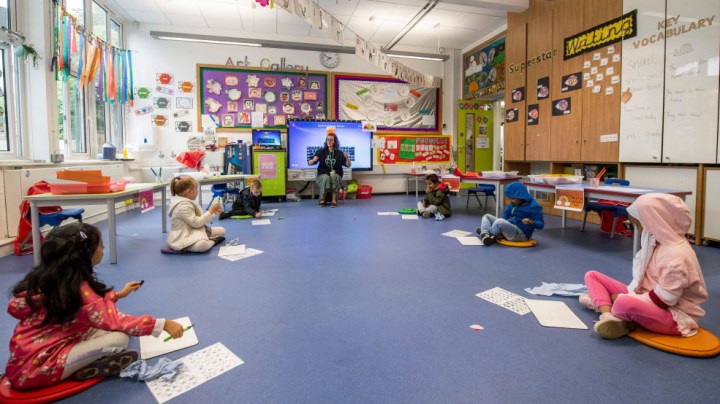
Substitute teaching is even tougher during the COVID-19 pandemic
Substitute teaching is even tougher during the COVID-19 pandemic

What school kid hasn’t rejoiced on hearing their teacher is out for the day and the class will get a substitute? It may seem great fun for students. But think about the substitute teacher, either doing lessons on Zoom or parachuting into a socially distanced classroom with all the risks involved.
With so many regular teachers getting sick, going into quarantine or experiencing burnout, subs are needed more than ever.
Substitute teacher Patrice Pullen of Orlando, Florida, prepared for the challenge early. “I had full regalia on,” she said. “I had the face shield, my gloves. And I said to the kids, ‘I’m your new warrior teacher. You guys are my warrior students.’ I said you’re so brave.”
She considers the students brave because they are in school in-person during the pandemic. Not only that, but she admires them for enduring a revolving door of teachers. The district started the year with everyone learning remotely, but then the school switched to a hybrid model of in-person and online learning.
Some teachers didn’t want to come back to the classroom, so more subs were needed, which means Pullen teaches a lot of subjects to a lot of grades.
“I went from art middle school, art high school. And then history. And this long-term one that I’m in now is honors biology and chemistry,” she said.
Pullen admits she’s not actually teaching biology and chemistry. She’s a facilitator, which means she’s only in the classroom to take attendance and to help students with technical problems, while their regular teacher handles the instruction from quarantine at home, virtually.
But Pullen said she’s needed, since “you can’t just have the students in the classroom by themselves … the kids that are face to face need an adult there.”
Teaching in a pandemic requires more teachers. They’re needed to assist in large or hybrid classes and also to give kids in special education the extra attention that’s required. Local newspapers are full of stories about districts scrambling to find subs.
Nicola Soares, president of Kelly Education, a national placement service for substitute teachers, agrees. “Every single state, every single school district has massive needs,” she said. She finds that some districts have lowered requirements and are no longer asking for a teaching certificate or anything more than a high school diploma.
And Soares thinks the need for subs will grow as the pandemic drags on because the country was already facing a teacher shortage before the pandemic began.
“We don’t have enough of the traditional students coming out of the teacher preparation programs in order to make sure we’re replenishing those openings, if you will,” she said.
Schools have already been relying more and more on long-term substitutes to fill holes and keep budgets down. In some ways, subs are the original gig workers. On average, they make about $15 an hour, and they rarely get the same benefits as permanent teachers, like health insurance and paid time off.
Jose Castrejon, who is a substitute teacher in Santa Ana, California, jokes, “I’m pretty sure we could look at any babysitter rate, and they’d probably get paid higher per kid.”
Although even in normal times being a sub is hard work — having to pick up other teachers’ lesson plans on everything from Spanish to algebra to gym — the in-person job had its rewards.
“Even if you had something like that prior to COVID, pre-distance learning, you could at least go around, walk around, see if you could be of any help and at least interact with the students,” said Castrejon.
But these days subbing online no longer offers those rewards and ends up being little more than taking attendance and keeping an eye on students as they do their work.
Still, Castrejon is not in a rush to return to the classroom. He lives with his dad and does not want to risk exposing him to the virus.
So the pandemic has a lot of substitute teachers wondering, just like full-time teachers, whether it’s worth going back to their jobs at all.
That’s expected to create yet another problem for school systems: Who’s going to sub in for the subs?
There’s a lot happening in the world. Through it all, Marketplace is here for you.
You rely on Marketplace to break down the world’s events and tell you how it affects you in a fact-based, approachable way. We rely on your financial support to keep making that possible.
Your donation today powers the independent journalism that you rely on. For just $5/month, you can help sustain Marketplace so we can keep reporting on the things that matter to you.


















